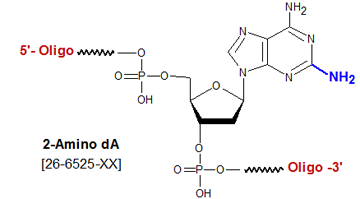
Modification : 2-Amino dA
Catalog Reference Number
Category
Modification Code
5 Prime
3 Prime
Internal
Molecular Weight (mw)
Extinction Coeficient (ec)
Technical Info (pdf)
Absorbance MAX
Emission MAX
Absorbance EC
26-6525
Duplex Stability
[2Am-dA]
Y
Y
Y
328.22
15.4
PS26-6525.pdf
-
-
-
2-Amino dA, Catalog#: 26-6525 has been discontinued effective June 25, 2025 and replaced by a more stable identical final modification
of 2-6-diaminopurine (2-Amino dA) Catalog#: 26-6504. The original 2-Amino dA catalog number 26-6525 precursor base was labile and required mild synthesis conditions with low yield. The substitute is more stable.
2-6-diaminopurine (2-Amino dA) Catalog: 26-6504-XX.
2-Amino-deoxyadenosine dA (also known as 2-6 diamino purine) can be used to improve the ability of an oligo to hybridize to its target. The 2-Amino-A nucleotide base forms three hydrogen bonds with thymine (T), compared with only two H-bonds between unmodified A and T. 2-Amino A:T base pairs thus have the same number of H-bonds as G:C base pairs do. Consequently, when a 2-Amino-dA oligo binds to its unmodified target, the Tm of the duplex is raised by 3oC per 2-Amino-dA residue added, compared with the unmodified case (1). In addition, 2-Amino-A also destabilizes A-G wobble mismatches, presumably due to a steric clash between the 2-amino on A and the 2-amino on G. Thus 2-Amino-dA modified oligos show better specificity for a target than their unmodified counterparts.
Modifications Increasing Duplex Stability and Nuclease Resistance
|
Modification
|
Duplex Stability [Tm Increase]
|
Nuclease Resistance
|
| Locked Analog Bases |
Increased [2- 4C per substitution] |
Increased |
| 2-Amino-dA |
Increased [3.0C per substitution] |
Similar to DNA |
| C-5 propynyl-C |
Increased [2.8C per substitution] |
Increased |
| C-5 propynyl-U |
Increased [1.7C per substitution] |
Increased |
| 2'-Fluoro |
Increased [1.8C per substitution] |
Increased |
| 5-Methyl-dC |
Increased [1.3C per substitution] |
Similar to DNA |
| 2'-O Methyl |
Increased |
Increased |
| Phosphorothioate |
Slightly decreased |
Increased |
|
Click here for complete list of duplex stability modifications
|
2-Amino dA has been shown to be particularly useful in the following oligo-based applications:
(a)Strong-binding PCR primers: 2-Amino-dA-modified PCR primers have been shown to prime far better than their unmodified counterparts in PCR reactions, consistently yielding more product per cycle, permitting amplification at very high annealing temperatures (as high as 72oC), and interestingly, allowing excellent priming from within palindromic sequences (1). The improvement in priming efficiency could significantly reduce the number of amplification-related mutations in PCR products. 2-Amino-dA primers also could be useful in several PCR applications, e.g., when short, specific primers are required, when only a limited quantity of template is available (e.g.ancient DNA), when DNA secondary structure in the primer binding site prevents binding of an unmodified primer, or when primer extension is blocked by downstream DNA secondary structure in the template.
(b)Selective Binding Complementary (SBC) Oligos: SBC oligos are complementary pairs of oligos that contain one or more modified base pairs (that is, each member of the pair is modified). Each individual modified base does not form a stable base pair with its modified partner, but does form a particularly stable base pair with its natural (unmodified) counterpart. Thus, two complementary SBC oligos do not form a stable duplex with each other, but each individual SBC oligo does form a very stable duplex with an unmodified complementary target. This property enables an SBC duplex to effectively bind with both the sense and anti-sense strands of a DNA or RNA duplex target. SBC oligos. SBC oligos are useful as probes for investigation of branching secondary structures, and as anti-sense reagents against mRNA that has significant secondary structure.
An excellent pair of SBC oligos can be made by substituting 2-Amino-dA for A, and 2-Thio-dT for T. Because 2-Amino-dA only forms one hydrogen bond with 2-Thio-dT, these modified base pairs are very weak, and the corresponding duplex is unstable. However, both 2-Amino-dA and 2-Thio-dT bind effectively with T and A bases, respectively. In a classic study, SBC 20mers annealed against a DNA 20mer target exhibited Tm values 10° higher than the corresponding DNA-DNA hybrid, whereas the SBC-SBC hybrid yielded Tm values 30° lower (2).
References
Lebedev, Y.,
et al. Oligonucleotides containing 2-aminoadenine and 5-methylcytosine are more effective as primers for PCR amplification than their unmodified counterparts.
Genetic Analysis: Biomolecular Engineering (1996),
13: 15-21.
Kutyavin, I.V.; Rhinehart, R.L.; Lukhtanov, E.A.; Gorn, V.V.; Meyer, R.B.; Gamper, H.B.
Oligonucleotides Containing 2-Aminoadenine and 2-Thiothymine Act as Selectively Binding Complementary Agents. Biochemistry (1996),
35: 11170-11176.
- 2-Amino dA
